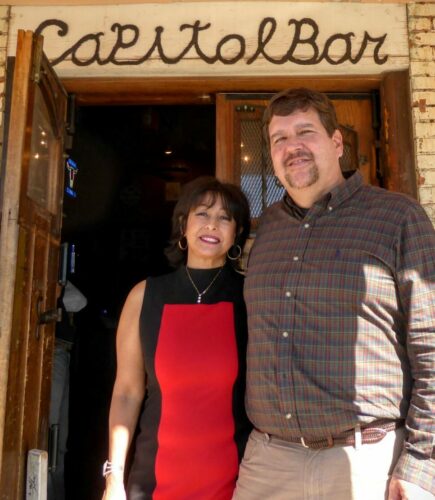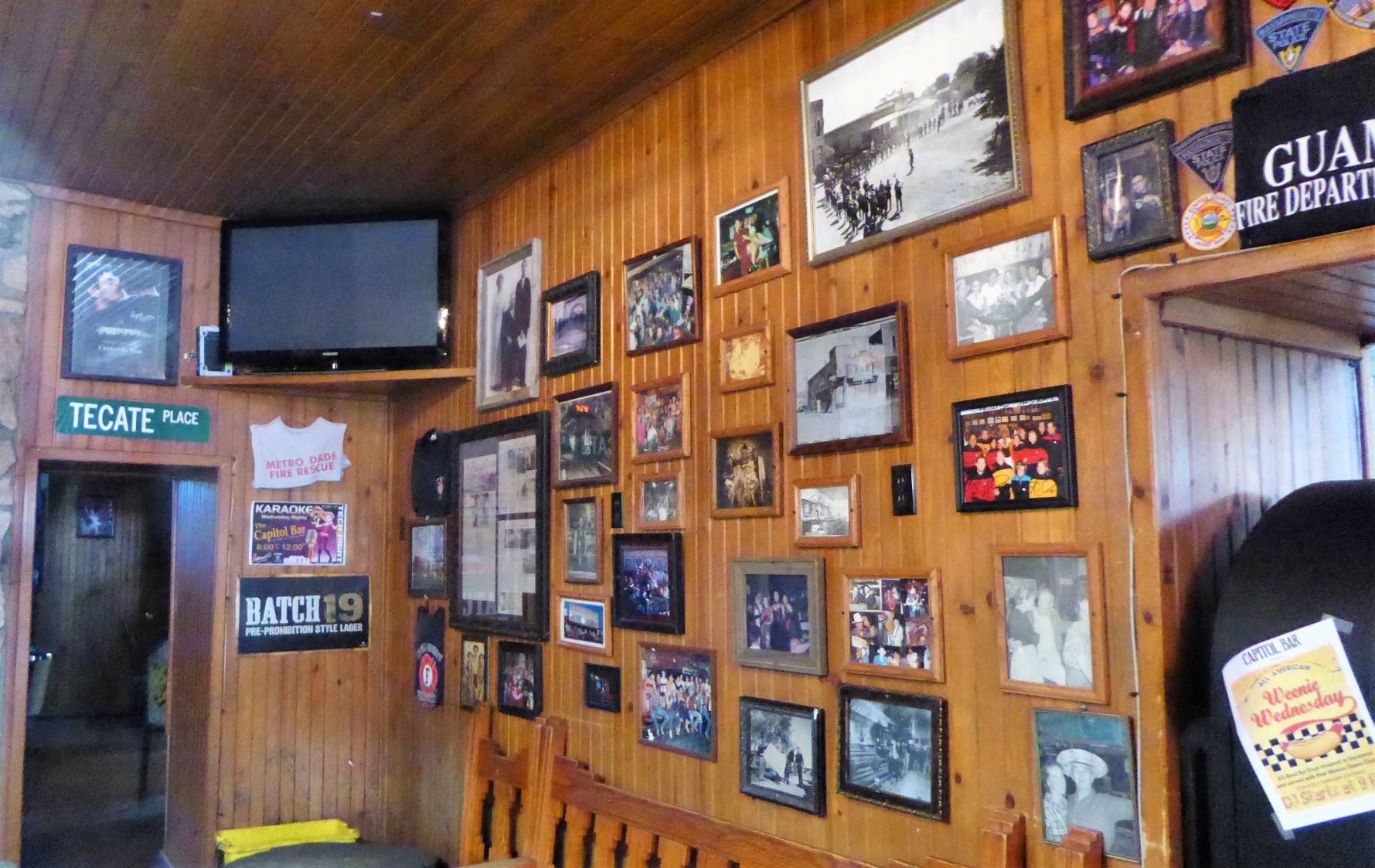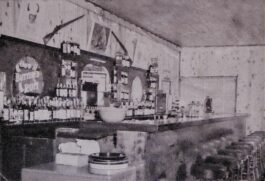
Besides the venerable bar itself, memorabilia from bygone years adorn the interior of The Cap as reminders of its colorful history.
John Larson | El Defensor Chieftain
The term iconic may get tossed around all too often for one reason or another, but as far as the history of New Mexico goes, there are at least two places in Socorro that deserve that appellation. One is San Miguel church. The other is the Capitol Bar.
2021 marks the 125th year the Capitol Bar has been in business, and last week the Economic Development Department announced that it has been awarded a $50,000 grant so it can accommodate a brewery and a morning coffee business, expanding sales and diversifying revenue. EDD Cabinet Secretary Alicia J. Keyes pointed out in a press release that this can lead to more steady year-round revenue.
“Family-owned businesses are the backbone of the state economy,” Keyes said. “This partnership with Capitol Bar & Brewery through LEDA is an important tool to help Socorro move toward a sustainable recovery.”
Dating back to its opening in 1896, for the last 58 years the bar has been owned and operated by the DeBrine family, most recently by Earl and Joanna DeBrine.
“We’re really excited about this. I think this is a good, positive change for the bar,” Joanna said.
She said adding the coffee shop will enable an earlier opening and locally-brewed beer will be a draw for Bosque del Apache and outdoor recreation tourists on their way to visit Socorro’s historic Plaza.
“State assistance means everything for us,” she said. “We think these changes will contribute to the community, and increase tourism and hiring. This bar has a lot of history and tourists want to come and see it. If we can expand the hours, open earlier for coffee and then stay open longer, we can help the city and the other businesses near the plaza. We have the most beautiful plaza in the entire state. It’s just beautiful.”
She said she and Earl have been talking about expanding for some time.

Joanna and Earl DeBrine
“Once we were forced to close because of COVID, we started wondering how we could reopen again quickly, you know with everyone being safe.” she said. “Then we thought, let’s work into putting the brewery in right now. And the coffee shop.”
It was when Joanne saw the announcement about LEDA funding, that she and Earl saw a way to put their expansion dreams into effect.
“And the intention too, was to see if it could revitalize the Plaza and help the local economy in being able to hire more people,” Joanna said. “We have tourists who stop by fairly often and we thought maybe this would increase the numbers.”
With the expansion Joanna speculates that the number of employees could increase from 8 to 14 over the next three years.
Installation of the brewery equipment in the back room of the bar began last Sunday. Joanna explained the reasoning behind it.
“Judge Amos Green was the second owner of the Capitol Bar. That back room was a jail cell,” she said. “The judge held court in the front of the saloon and jailed prisoners in the back. So our thinking is based around Judge Greene’s jailhouse.”
In the intervening years, the business has been fortunate to have a loyal clientele with not only longtime locals, New Mexico Tech students, parents, faculty, and participants of New Mexico Tech’s First Responder Program.
Live music and dancing is a long standing weekend tradition for the bar, which has been thought of by many as one of Socorro’s historical landmarks, a venerable establishment on the same plane as New Mexico Tech or San Miguel Church.
The story of the Capitol Bar is one of community. Over the last 125 years it has survived fires, prohibition, a couple of name changes and a handful of owners. It has been a fixture on Socorro’s plaza since opening in 1896.
“We don’t know the exact day, but it was in October, 1896, and that was based on a Chieftain article,” Joanna said in a 2016 interview.
Socorro in 1896 was an understandably different place, and bars were thriving.
“Back then the silver boom had just ended and at one time Socorro was the biggest city in New Mexico,” Earl Debrine said. “Mostly because it was a tent city with all the prospectors living here. That’s why you had a town that could support 30 saloons.”
The bar has been in the DeBrine family for 58 of those 125 years.
The previous owners were Earl’s parents; Earl Sr. and Emerlinda “Mernie” DeBrine.
“My dad, Earl DeBrine Sr., followed his brother, Bruce DeBrine, from Rochester, New York, to attend New Mexico Tech,” Earl said. “Dad started out tending bar at the Capitol, and then he leased it from Willie Emilio beginning in 1963.”
The senior DeBrine ended up purchasing the bar outright in the 1970s. A rumor goes that its basement became an unofficial classroom for Tech students studying subjects of both higher and lower learning.
“So, it’s really been a part of the family really since ’63,” he said. “The bar is essentially the same since it was built by the Biavaschi brothers.”
The story of the Cap begins with the wine-making émigrés from Italy, the Biavaschi brothers.
“The two immigrant brothers, Giovanni and Tobaschi Biavaschi, used stone, adobe and brick to build the saloon in 1896 in order to sell Giovanni’s wine,” Earl said.
In other words, a bodega and bar; the Biavaschi Saloon.
“At that time the Socorro region was known for its wine production,” Earl said. “There’s actually an old New York Times article of someone traveling through New Mexico that mentions Socorro and its vineyards.”
“We were one of 30 saloons, and Socorro was the largest city in the New Mexico Territory at the time,” Joanna said. “We like to say that when we started the only things here were the Capitol, New Mexico Tech and San Miguel Church.”
The Biavaschis eventually sold the bar to Amos Green, the Socorro Justice of the Peace who renamed the business the Green Front. Green paint can still be seen on the bricks.
Judge Green’s custom was to hold court in the bar, and there was a jail in the back for the guilty. Although the jail is long gone, the bars on the window are still visible.
“Judge Green would conduct all legal business here in the bar, weddings also,” he said. “One story is that he would charge the couple according to the beauty of the bride.”
To this day people still occasionally ask to have their weddings in the bar, he said.
“We’ve had weddings … receptions. Maybe a dozen couples said their vows in here,” Earl said. “I know, because I was witness for two.”

Photographs on the walls of The Cap recall past years when a local judge held court at the bar and prisoners were locked up in a backroom jail.
John Larson | El Defensor Chieftain
During prohibition the Capitol was turned into a pool hall and speakeasy, where drinks were 25 cents a shot. It’s said that moonshine smuggled in from Magdalena was also available.
“A trap door behind the bar led to the basement, providing an escape route from the law during that period,” he said.
The Capitol is listed on the New Mexico Register of Historic Places.
“Back in the day they’d open at 7 a.m. There’d be a full bar of people who’d start their day here,” he said.
“The breakfast club,” Joanna added. “For a while the District Attorney, the judges and lawyers would all come in here for drinks. And they’d all leave together. It happened all the time.”
Several noticeable changes have taken place since the 1990s.
“Lightning struck in
1993 and so the interior was completely charred, but it was redone like it was before,” Earl mentioned. “The bar looked different back then, and from what my mom did, too, was she opened up the old windows on the front, because those were all boarded up. And the ceiling was lower.”
The dance hall adjoining the barroom was previously a café, and one can still see the entrance to the café behind the bar. Next door to the building was an empty lot, until a patio was installed around 1994. “There was an old shack on it, as I remember growing up, a
nd there was parking there,” he said. “It was converted by my mother, she owned it. My father passed away in ’87 and then my mom assumed it.”
“We put a lot of work into the patio,” Joanna said.
As fitting for an old west watering hole, the Cap reflects the character and attitude of its countless patrons over the years. Curiosities abound, including a military sword taken from a captured German soldier in World War I mounted above the bar.
“It was given to my father by a customer named Earle Denise, but everyone called him Sarge because he was a veteran of both World War I and World War II,” Earl said. “This was his home away from home, you know. He lived in Lemitar.”
There’s an array of commemorative Jim Beam bottles lining the wall above the bar, and a crocodile skin attached to the ceiling.
A hat perched on deer antlers, according to Joanna, belonged to a local farmer.

Not much has changed at the venerable establishment as evidenced by this historical photograph gracing a wall of the Capitol Bar.
“There was an old time rancher who would come in here every day and have a couple of beers and then go home, and he did that for quite a while,” she said. “When he passed away his family asked if they could have a memorial here. And my brother-in-law at the time was working and said, sure you bet, on the day they requested.”
“So they came in the morning about ten o’clock, and started coming through the door with a casket,” she said. “And my brother-in-law says, ‘well, what do you think you’re doing?’”
They told him they were bringing the coffin in.
“He said wait a minute, wait a minute, you said a memorial, but didn’t say you’d bring in the body,” Joanna said. “They said they thought they’d have the entire service here, and he said, ‘I don’t think the state will let us do that.’”
In the end the family had the memorial without the body, “and then asked to have his hat put up there,” she said. “Because he loved this place so much.”
She said some people have also brought in family members’ ashes for one last drink.
The state LEDA funds will be paid out as the company meets economic development benchmarks established in the project participation agreement, which will be managed by the City of Socorro.
“The City of Socorro is enthusiastic and greatly encouraged to learn that Capitol Bar has qualified for a LEDA grant,” Socorro Mayor Ravi Bhasker said. “This program helps businesses expand to reach their potential, thereby adding to the economic prosperity of a community. The City of Socorro is eager to participate in this concerted effort to revitalize the historic Socorro Plaza area and to ensure our businesses thrive.”
The Cap will be celebrating its 125th year in October.
“We’re looking forward to having something special in October,” she said. “Especially the idean of people being around other people again, and coming in and going out, and enjoying each other’s company.”
Joanna summed up the impact the bar has on Socorro.
“I’d say it’s the only place you can go to where you can find people from all different walks of life, from completely different backgrounds. And they’re friends,” she said. “They’re friends because of this place…just a place they can come to have a drink and visit.
“We’re figuring out how we can keep it going for another 125 years,” she said.















